GET IN TOUCH
- Please wait...
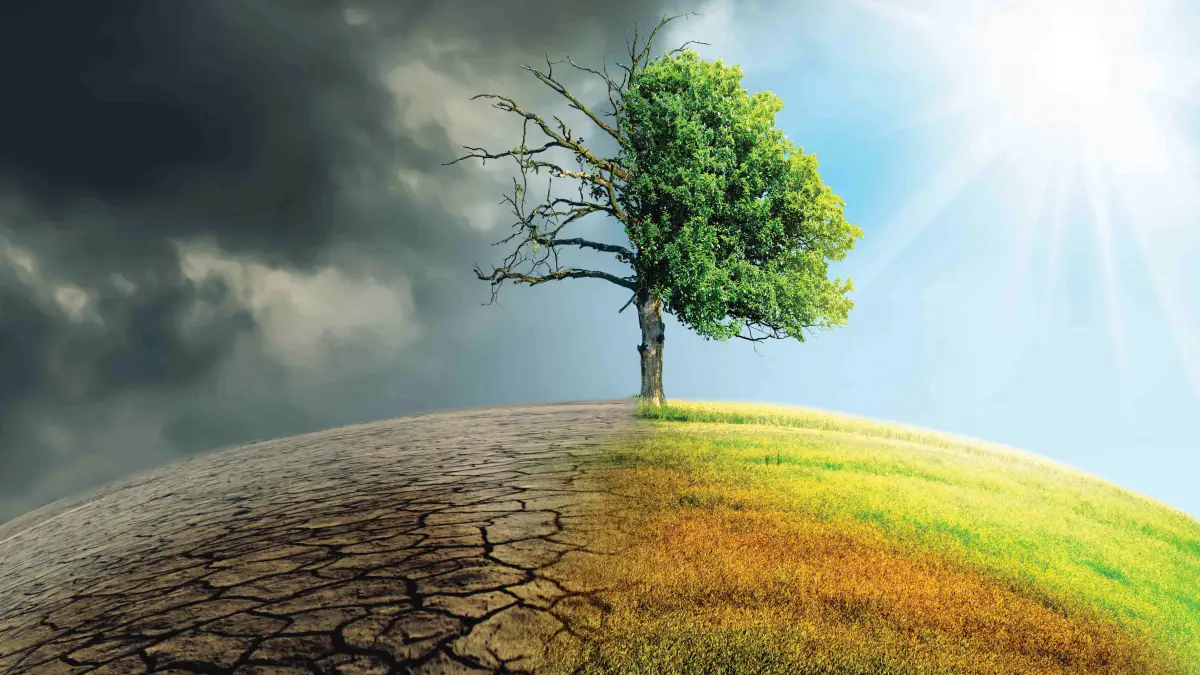
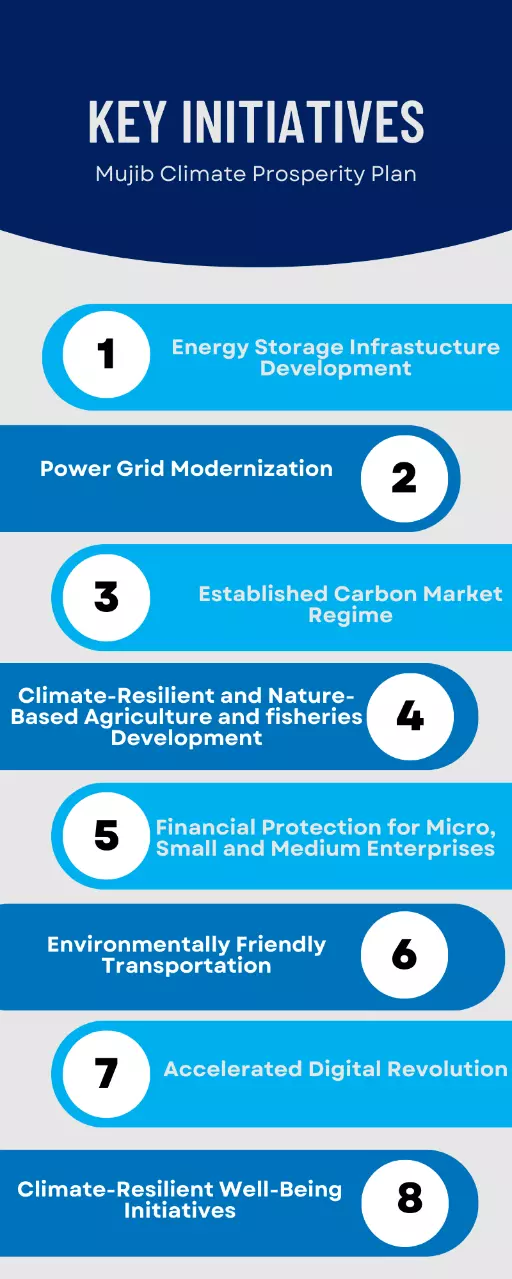
Bangladesh, despite its minimal contribution, which is less than 1%,[1] to worldwide greenhouse gas emissions, is at a high risk of experiencing the negative impacts of climate change. This is primarily due to its geographical location, population density, and dependence on agriculture. The country ranked seventh in the global climate risk.[2] Thus, the formulation of the Mujib Climate Prosperity Plan (MCPP) was prompted by the pressing need for Bangladesh to tackle the adverse effects of climate change, which have the potential to cause severe harm to the nation’s economy, environment, and society. The plan for Bangladesh is focused on building a sustainable economy that is resilient to climate adaptation and mitigation. The plan will be achieved through investments in renewable energy, energy efficiency, sustainable agriculture practices, and the reduction of greenhouse gas emissions.
The MCPP aims to improve the nation’s ability to cope with the consequences of climate change, including rising sea levels and other extreme weather conditions. Bangladesh launched the Mujib Climate Prosperity Plan Decade 2030 during its second tenure as president of the Climate Vulnerable Forum (CVF).
The plan is aligned with Bangladesh’s vision to promote a more sustainable and prosperous future for everyone and aims to showcase the potential of achieving this goal. The Mujib Climate Prosperity Plan is a strategic initiative that aims to transform Bangladesh’s future by moving it away from a vulnerable state towards one of resilience and prosperity. The Mujib Climate Prosperity Plan has a long-term perspective that goes beyond 2040 to mid-century, in line with the Climate Vulnerable Forum Vision and the Paris Agreement. It is crucial that this shift takes place by 2030.
The Mujib Climate Prosperity Plan is a comprehensive strategy designed to steer Bangladesh toward a sustainable and low-carbon future. It encompasses a range of initiatives and measures that prioritize economic growth while simultaneously reducing greenhouse gas emissions and strengthening the country’s ability to cope with the effects of climate change.
The MCPP has identified six key areas of focus, which includes:
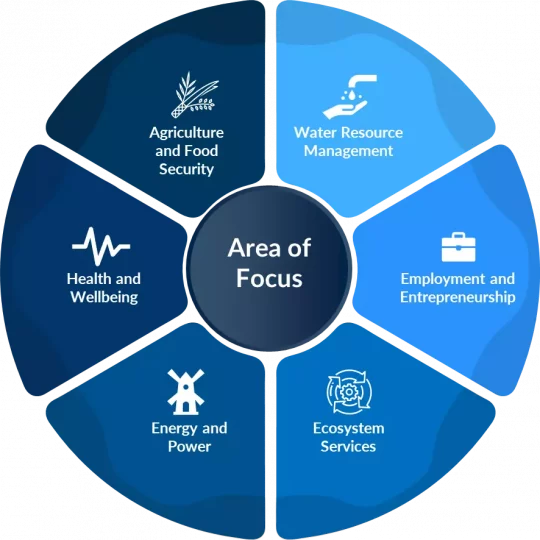
The MCPP aims to enhance the use of renewable energy sources and energy efficiency measures in Bangladesh’s energy sector, with the objective of augmenting the proportion of renewable energy in the country’s energy mix. The plan is focused on achieving specific objectives related to the implementation of renewable energy sources like solar, wind, and hydroelectric power.
Additionally, it emphasizes the incorporation of energy-efficient technologies in buildings and industries. The goal is to achieve a significant increase in the use of renewable energy sources, aiming for 30% by 2030 and at least 40% by 2041. [3]However, currently as per Sustainable Renewable Energy Development Authority (SREDA), renewable energy production in Bangladesh is relatively limited in scale (3.71% of the total energy mix) [12] and as follows:
| Technology | Off-grid (MW) | On-grid (MW) | Total MW |
|---|---|---|---|
| Solar | 365.68 | 594.33 | 960.01 |
| Wind | 2 | 0.9 | 2.9 |
| Hydro | 0 | 230 | 230 |
| Bio-gas to electricity | 0.69 | 0 | 0.69 |
| Biomass to electricity | 0.4 | 0 | 0.4 |
| Total | 368.77 | 825.23 | 1194 |
At present, solar, biogas, wind, and hydroelectric power are the dominant renewable energy sources in Bangladesh. The country’s primary hydroelectric power plant, the Karnaphuli Hydro Power Station, generates 230 MW of electrical energy, making it the sole facility of its kind in the nation.
Despite the formulation of the MCPP, limited progress has been made in the development of renewable energy sources, resulting in a relatively small contribution to overall power generation. While electric vehicles (EVs) are yet to gain popularity, the absence of a robust charging infrastructure has also hindered its widespread adoption. It is imperative for Bangladesh to promptly commence the establishment of EV charging facilities to meet the impending surge in demand for EVs. Side by side, it is essential to have policy backing that promotes the manufacturing of electric vehicles and lithium-ion batteries to boost their adoption.
At present, there are only 14 solar-powered EV charging stations with a combined capacity of 282 kW. Most electric vehicles currently depend on residential charging systems, making it necessary to integrate EV charging facilities into existing compressed natural gas (CNG) and fuel stations, as well as parking lots.
Furthermore, there is a major lack of policy coordination among stakeholders. To increase the uptake of solar home systems across the country, Infrastructure Development Company Limited (IDCOL) a government-owned non-banking financial institution (NBFI), ran programmes from 2003-2019. However, the simultaneous execution of multiple programmes eventually crossed out the positive effects. The power distribution companies also started to expand the grid electricity supply to meet the government’s ‘100% electrification by 2021 campaign’. Thus, a lack of policy coordination among stakeholders led to mismanagement and inefficient usage of resources.
According to the World Bank, the country now ranks as the 35th largest economy in terms of GDP growth, which consequently calls for an increase in renewable energy consumption. Thus, it is imperative that the government starts planning effectively in coordination with the relevant stakeholders and accomplish the defined objectives through the implementation of grid resilience and modernization measures.

The MCPP aims to encourage sustainable agriculture practices and decrease the emissions intensity of food production in the agriculture and food security sector. This includes initiatives such as promoting organic farming, improving irrigation systems, and enhancing the efficiency of fertilizer and pesticide use. The budget estimated till 2030 for this is around USD 2.02 billion. [3]
The plan further encompasses a range of strategies that are tailored to specific sectors, as well as broader initiatives that cut across multiple sectors. These cross-cutting efforts include promoting environmentally friendly entrepreneurship and supporting research and development of low-carbon technologies.
The plan aims to improve the ability of Bangladesh’s infrastructure and communities to withstand the effects of climate change, such as cyclones and flooding, by promoting climate-resilient infrastructure and nature-based solutions. Thus, it outlines a strategic path for Bangladesh to attain its developmental objectives while simultaneously advancing a sustainable and resilient future with a minimal carbon footprint.
The Mujib Climate Prosperity Plan’s social aspect prioritizes the promotion of social justice and inclusiveness in the realm of climate action and sustainable development. This further aligns with the notion of ‘Just Transition’, which, according to the International Labour Organization (ILO), involves transforming the economy in an environmentally responsible manner that is equitable and inclusive, providing decent work opportunities, and ensuring that no one is left behind particularly poor and marginalized people impacted by climate adaptation measures by shifting towards circular business models.
The MCPP placed a significant emphasis on women, as they bear the brunt of climate change’s negative consequences more frequently than males. Due to traditional gender norms and long-standing social conventions, the impact is greater on them. Climate change effects and events force men to migrate to cities in search of employment opportunities leaving female family members behind in a relatively insecure social position.
In order to promote the economic empowerment of women, focused skills development programs will be implemented, tailored to the specific needs of women. Prioritizing gender-responsive training that encompasses pertinent skills, in conjunction with fiscal stimulus packages and social protection programs, will be of utmost importance. [3] Moreover, the MCPP’s goals include bolstering the resilience of vulnerable populations to climate change by increasing their access to information, finance, and opportunities for decision-making.
To improve the well-being of climate migrants, it is essential to provide accessible housing, basic services, and livelihood opportunities in disaster-prone areas. Social integration strengthened social safety nets, and access to education is crucial for their overall welfare. Additionally, focusing on disaster preparedness, fostering international cooperation, and involving migrants in decision-making processes are vital for sustainable solutions.
A notable example of an ongoing initiative is the Ashrayan Project, which aims to incorporate underprivileged, landless, and homeless individuals into inclusive development. This innovative method of tackling poverty and promoting inclusive development has led to the successful rehabilitation of more than 3.5 million individuals since its inception in 1997.
This program encompasses individuals affected by natural disasters, various ethnic communities, third-gender individuals, Dalits, Harijans, and other marginalized groups. It stands as a groundbreaking and monumental endeavor, providing free housing to the underprivileged in the state, with the ultimate goal of integrating them into mainstream society.
These aspects can be further addressed through the implementation of MCPP and thus, it is possible to enhance the living conditions and support the resilience of climate migrants. The successful implementation of the MCPP presents a promising avenue to effectively tackle these challenges, thereby potentially improving living conditions and bolstering the resilience of climate migrants.
Education and awareness-raising campaigns are prioritized in the plan to increase people’s understanding of climate change and motivate them to adopt more sustainable habits. Sustainable and resilient infrastructure, such as affordable housing, a safe water supply, and resilient transportation, are encouraged by the plan in order to boost community well-being and quality of life. The incorporation of local organizations and community leaders in the planning and implementation processes reflects the plan’s acknowledgment of the value of social cohesion and community-based approaches to climate change.
The goal of the strategy is to improve the social protection system so that those who are particularly vulnerable due to climate change can receive the help they need. Through measures like early warning systems and disaster response mechanisms, the strategy hopes to boost public health and make the health sector more resistant to the effects of climate change.
In addition, the strategy highlights the value of cultural heritage and encourages the safeguarding of cultural sites and traditions that are threatened by climate change. To advance social equality and justice in the context of climate adaptation and mitigation, the plan highlights the significance of partnerships and collaboration among many sectors and stakeholders, such as government agencies, civil society organizations, and the commercial sector.
The integration of the Mujib Climate Prosperity Plan with the Digital Bangladesh initiatives of the government will promote effectiveness, openness, and responsibility, and facilitate Bangladesh’s transition towards the Fourth Industrial Revolution. The utilization of modern technology in this program will enable the delivery of government services directly to citizens’ doorsteps.
The Mujib Climate Prosperity Plan prioritizes governance by enhancing institutional capacity, encouraging public involvement, and enhancing accountability and transparency in the realm of climate action and sustainable development. Some key points in this aspect are:
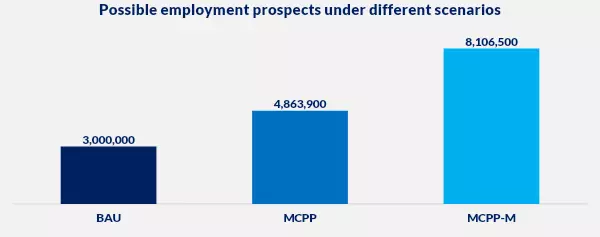
*Note: Business-As-Usual (BAU): Uses the reference scenario in Vision 2041, Mujib Climate Prosperity Plan (MCPP): Realistic climate prosperity scenario based on current and expected prospective access to resources and support. Mujib Climate Prosperity Plan Maximized (MCPP-M): Maximized climate prosperity scenario based on a significant increase in resources made available both from international support and the private sector (domestic, regional, and international)
The inclusion of monitoring, evaluation, and reporting mechanisms in the plan is crucial to ensure accountability and track progress effectively. The MCPP has a significant goal of establishing Bangladesh as a front-runner in climate action and sustainable development. This will play a crucial role in supporting worldwide endeavors to attain the objectives of the Paris Agreement and the United Nations Sustainable Development Goals.
In recent times, if we look at the garments industry, local suppliers are taking steps towards sustainability and workplace safety by constructing green garment factories, with the aim of improving the industry’s reputation. It is noteworthy that there are 65 garment units in the country that have achieved platinum ratings from the Leadership in Energy and Environmental Design (LEED) programme of the US Green Building Council (USGBC), making them global champions in green factories. [4]
Green factories have been found to significantly reduce energy consumption by up to 40% and decrease water usage by over 30%. Additionally, they emit lower levels of carbon dioxide, which contributes to a safer and healthier environment. This information has been reported by Bangladesh Garment Manufacturers and Exporters Association (BGMEA). [5] Bangladesh’s RMG sector has made significant strides in adopting eco-friendly manufacturing practices. As of February 2023, there are 65 factories in the platinum category, 110 in gold, 10 in silver, and 4 LEED-certified buildings.
Furthermore, the rooftop solar sector shows great potential, especially among major manufacturers, particularly those in the green apparel industry, who are installing solar panels on their rooftops. The introduction of the net metering policy in 2018, along with the increasing energy prices, has provided manufacturers with additional motivation to establish renewable energy sources.
According to sources at the BGMEA, an additional 500 garment factories are currently in the process of obtaining LEED certification from the USGBC in recognition of their environmentally friendly practices. The USGBC reports that China and Bangladesh have the highest number of platinum rated factories, with China having 10 and Bangladesh having the most. Pakistan follows closely behind with nine platinum rated factories. [6]
The Mujib Climate Prosperity Plan’s financing strategy is designed to gather and maximize financial resources from both the public and private sectors to facilitate the execution of the action projects. Firstly, the MCPP recognizes the significance of domestic resource mobilization, such as taxation and public-private partnerships, in funding climate action and sustainable development projects.
Secondly, the plan intends to utilize global climate finance resources such as grants, concessional loans, and climate funds to facilitate the execution of essential initiatives. In doing so, collaboration with other countries and the formation of alliances for gathering financial resources is crucial.
Thirdly, the MCPP aims to encourage the private sector to invest in sustainable development and climate action projects by introducing innovative financial tools such as green bonds. Furthermore, the plan recognizes the significance of generating financial resources to aid adaptation endeavors, especially in communities that are susceptible to risks and have limited financial means.
Moreover, the MCPP aims to enhance financial inclusion and provide marginalized communities, such as low-income households and women, with access to finance, which can help improve their social and economic welfare. The importance of sustainable and resilient infrastructure, such as affordable housing, safe water supply, and resilient transportation, in attracting private sector investment is clearly highlighted in the Mujib Climate Prosperity Plan.
Recently, the Prime Minister launched a new initiative to speed up the process on 11 December 2022: the Global Center on Adaptation (GCA) Global Hub on Locally Led Adaptation. As a global platform on climate adaptation for the urban poor, the programme hopes to aid Bangladesh’s 1 million climate-vulnerable migrant workers.[7]
Another roundtable discussion, hosted by the GCA CEO Prof. Dr. Patrick Verkooijen with other local and foreign dignitaries, was held on the initiative on 13 March 2023. The main topics of discussion were GCA’s dedication to working hand in hand with the Government of Bangladesh to close the climate adaptation financing gap, and the ongoing efforts to mainstream adaptation and Nature-based Solutions into the design of investments totaling over USD 1 billion financed by Multilateral Development Banks like the Asian Development Bank, the Asian Infrastructure Investment Bank, and the World Bank Group.[8]
Bangladesh is on its way to graduating from its LDC status in the year 2026. [9] This graduation means losing access to development financing like the Green Climate Fund and the LDC fund.
| Sl. | Name of the Fund | No. of Approved Projects | Amount of Fund (million $) | ||
| Grant | Loan | Co-finance | |||
| 1. | Green Climate Fund (GCF) | 05 | 101.14 | 250.00 | 156.66 |
| 2. | Least Developed Countries Fund (LDCF) | 07 | 34.41 | – | 187.94 |
| 3. | Adaptation Fund (AF) | 01 | 9.99 | – | – |
| 4. | Global Environment Facility (GEF)* | 08 | 24.66 | – | 402.62 |
| 5. | Climate Bridge Fund | – | 30.00 | – | – |
| Total | 200.20 | 250.00 | 747.22 | ||
However, the MCPP seeks to enhance Bangladesh’s position in the global supply chains by promoting export diversification and modernization. This will enable the country to remain competitive and relevant in the future. The potential loss of duty-free quota-free (DFQF) market access for Bangladesh’s exports due to the country’s LDC graduation by 2026 could be offset by this development. The strategy for export diversification involves taking advantage of environmentally friendly opportunities such as green logistics and power.
The integration of modernization will lead to a decrease in environmental hazards by enhancing supply chain involvement, such as the disclosure of environmental data. Ensuring the resilience of the nation’s supply chain is crucial for maintaining a strong global presence and minimizing the potential negative impacts that can arise from disruptions.
The Delta Plan 2100 and the Mujib Climate Prosperity Plan hand in hand shares a common goal of addressing climate change by mitigating greenhouse gas emissions and adapting to its impacts, particularly in the vulnerable delta regions of Bangladesh. The plans complement each other in policy formulation, ensuring that climate adaptation and mitigation strategies are integrated, coherent, and aligned with the specific needs and vulnerabilities of the delta regions. This approach can lead to more efficient use of resources and avoid potential conflicts or duplication of efforts.
The Delta Plan 2100 focuses on long-term strategies for managing water resources, protecting coastal areas, and enhancing climate resilience, while the Mujib Climate Prosperity Plan includes broader policies and measures to promote sustainable development while reducing carbon emissions. Both plans require strong governance and effective implementation to achieve their goals.
The Mujib Climate Prosperity Plan works as a precedent for other member nations to formulate their own version considering the stake at hand. The plan appears to hold promise for both the citizens of Bangladesh and the world, with the potential for substantial positive outcomes. The success of the project hinges on efficient execution, proper funding, and vigilant supervision. Collaboration between the government and stakeholders is crucial to ensure the effective implementation of the plan and equitable distribution of its benefits throughout society.
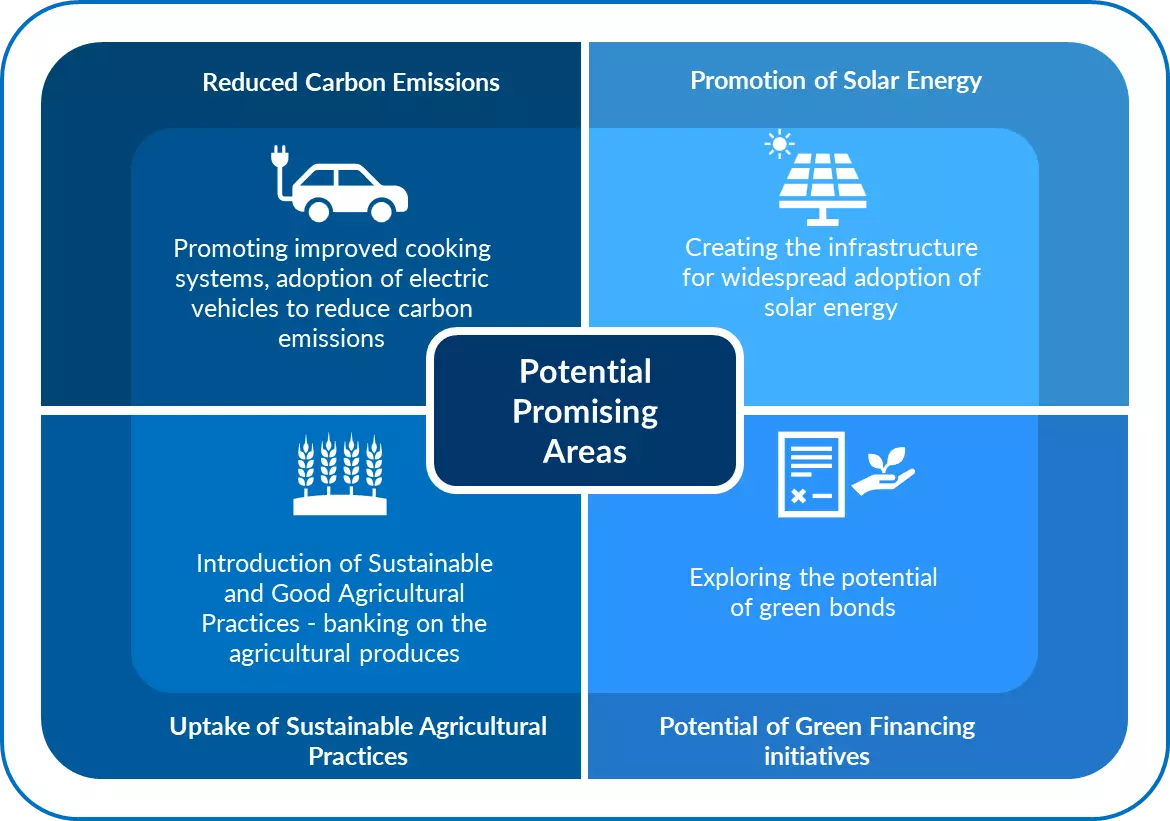
Syed Samiun Mostafa, a Content Writer, and Samiha Anwar, a Business Consultant at LightCastle Partners, have co-authored the write-up. For further clarifications, contact here: [email protected]
Our experts can help you solve your unique challenges
Stay up-to-date with our Thought Leadership and Insights